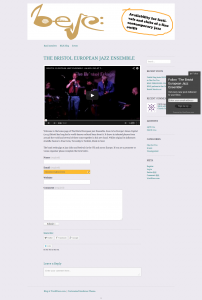Case Study 3: Sheffield Interfaith
Sheffield Interfaith approached me with the question: how do you set up a viable site with a limited budget?
How We Designed the Site
Three members of the group were willing to work on the site. So we set up a WordPress site, using the Genesis Streamline Pro theme. Genesis designed this theme for mobile phones and tablets and this imposes constraints on the header. Streamline Pro enables Sheffield Interfaith display information about its three constituent groups on the home page.
We were able to include the image intended for the header in the sidebar, so it is visible alongside every post and page.
The site is very simple although it has potential to expand as the group develops. The two main features are the blog and email list.
The home page is the main blog archive page on this site. If you scroll down past the three information pages, the latest post is visible with earlier posts beneath it. The Sheffield Interfaith site is mainly concerned with publicity for events and so this is a helpful way to showcase future events. The primary navigation allows visitors to view posts about current or archived events. Currently anything that is not an event is news but more categories can be added in the future.
Communication Through the Site
Members of the email list receive notice of new posts the day following their appearance. They also receive occasional newsletters. Existing members were added to the list and anyone who visits the site can subscribe. This means anyone interested can keep in touch. The group relies mainly on word of mouth and printed publicity to spread the word and so does not have to worry about search engines.
The organisation’s name is likely to be Googled and when it is their site is at the top. It has a domain authority of 10 and a page authority 23. This is not bad for a new site. It is impressive for a site that has only one inbound link!
Feedback from Sheffield Interfaith
So far I have had a little feedback from the group. One of them wrote:
I will prepare a testimonial but there was something that I wanted to say to you about the need to go at the pace of the customer. It has felt to me that the pace has been too fast and that there was not adequate space to ask questions and go back on things just to make sure that I understood how the website works, and how to maintain it. For me it is not just about design but about learning a new process.
I have felt that I have always been behind the curve and have been trying to catch up. Part of it no doubt is a matter of language – it has been complex for me to learn and I have been taken completely out of my comfort zone (beyond my knowledge base) and have had to grapple with something new. All this may be a result of the quote and the level of service that we agreed. I am having to do a lot of back filling just to make it easier for me to understand the whole thing. There is not a great deal of relevant IT literacy in the group.
Maybe as well as designing the website there was a hands on session on how to make posts, upload, maintain and deal with the likely issues that were to arise. This could be a need for others and I am not sure where we can go to in order to keep on top of things. This aspect is not part of the design process but it is something that needs to complement it. Maybe it is not something that is required to design a website but it is a need, especially as personnel change within organizations.
We do however have a clear and attractive website that is up and running and one that we can add to. It will be useful tool for SIF to use and to publicize.
Implications
I’ve shared this because it illustrates some of the issues working on this approach to websites. I offer a time limited service (3 – 6 months) where my clients can contact me by email, phone or Skype, to discuss issues. They also have a few short workshops, about 4 hours. One thing I shall do, as a result of this feedback, is to be clearer to future clients how they can use this service. Let’s be clear. No website can work properly if those responsible for it are unable to maintain it. The people development is as important, perhaps more important than the technology.
I’m also hoping to develop more material on this website to help past clients and any group working on their website. I’m hoping Sheffield Interfaith will tell me what information would help them and the same applies to anybody.
What do you need to know? If you would like to see specific “how to” posts on this blog, comment below and sign up to my list so that you can see when I respond!
